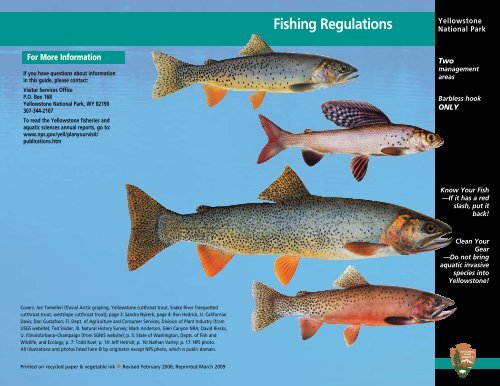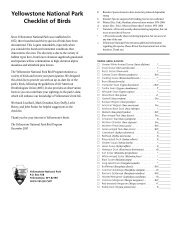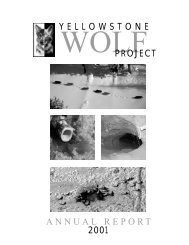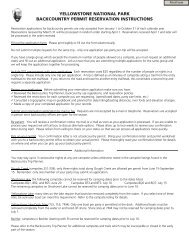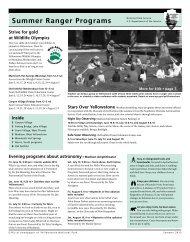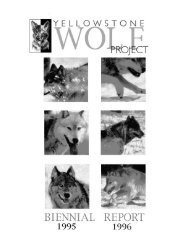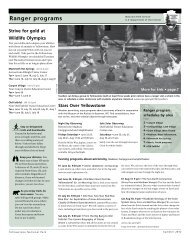Fishing Regulations - Yellowstone Up Close and Personal
Fishing Regulations - Yellowstone Up Close and Personal
Fishing Regulations - Yellowstone Up Close and Personal
- No tags were found...
Create successful ePaper yourself
Turn your PDF publications into a flip-book with our unique Google optimized e-Paper software.
<strong>Fishing</strong> <strong>Regulations</strong><strong>Yellowstone</strong>National ParkFor More InformationIf you have questions about informationin this guide, please contact:Visitor Services OfficeP.O. Box 168<strong>Yellowstone</strong> National Park, WY 82190307-344-2107To read the <strong>Yellowstone</strong> fisheries <strong>and</strong>aquatic sciences annual reports, go to:www.nps.gov/yell/planyourvisit/publications.htmTwomanagementareasBarbless hookONLYKnow Your Fish—If it has a redslash, put itback!Clean YourGear—Do not bringaquatic invasivespecies into<strong>Yellowstone</strong>!Covers: Joe Tomelleri (fluvial Arctic grayling, <strong>Yellowstone</strong> cutthroat trout, Snake River finespottedcutthroat trout, westslope cutthroat trout); page 3: S<strong>and</strong>ra Nykerk; page 4: Ron Hedrick, U. California/Davis; Dan Gustafson; Fl. Dept. of Agriculture <strong>and</strong> Consumer Services, Division of Plant Industry (fromUSGS website); Ted Snider, Ill. Natural History Survey; Mark Anderson, Glen Canyon NRA; David Riecks,U. Illinois/Urbana–Champaign (from SGNIS website); p. 5: State of Washington, Depts. of Fish <strong>and</strong>Wildlife, <strong>and</strong> Ecology; p. 7: Todd Koel; p. 14: Jeff Hetrick; p. 16: Nathan Varley; p. 17: NPS photo.All illustrations <strong>and</strong> photos listed here © by originator except NPS photo, which is public domain.Printed on recycled paper & vegetable ink u Revised February 2006; Reprinted March 2009
How to Use These <strong>Regulations</strong>1. Familiarize yourself with the GENERAL REGULATIONS, listed on pages6–7. They include permit requirements for fishing, boats, <strong>and</strong> float tubes;tackle & bait restrictions; <strong>and</strong> size or possession limits.2. See the map on pages 8–10 to determine which of the twomanagement areas within the park—the Native Trout ConservationArea or the Wild Trout Enhancement Area—you will be in.3. Read the POSSESSION LIMITS BY MANAGEMENT AREA on page 8 todetermine the allowed harvest. Catch-<strong>and</strong>-release is m<strong>and</strong>atory forcutthroat trout <strong>and</strong> all other native species in both management areas.4. Check if the stream or lake you will be fishing is listed on page 10 in theEXCEPTIONS TO GENERAL REGULATIONS.ContentsAquatic Invasive Species . . . . . . . . . . . . . . . . . . . . . . . . . . . . . . . . . . . . . 4–5General <strong>Regulations</strong>—fishing & boating . . . . . . . . . . . . . . . . . . . . . . . 6–7Management Area Limits <strong>and</strong> Map. . . . . . . . . . . . . . . . . . . . . . . . . . . 8–10Exceptions to General <strong>Regulations</strong> . . . . . . . . . . . . . . . . . . . . . . . . . . . . . 10Fish Identification <strong>and</strong> Distribution . . . . . . . . . . . . . . . . . . . . . . . . . 11–13Releasing Fish . . . . . . . . . . . . . . . . . . . . . . . . . . . . . . . . . . . . . . . . . . . . . . . 14Volunteer Programs . . . . . . . . . . . . . . . . . . . . . . . . . . . . . . . . . . . . . . . . . . 15Angler Etiquette . . . . . . . . . . . . . . . . . . . . . . . . . . . . . . . . . . . . . . . . . . . . . 15Illegal Actions/Reporting Violations. . . . . . . . . . . . . . . . . . . . . . . . . . . . 15<strong>Yellowstone</strong>’s Fishery . . . . . . . . . . . . . . . . . . . . . . . . . . . . . . . . . . . . . . . . 16Frequently Asked Questions. . . . . . . . . . . . . . . . . . . . . . . . . . . . . . . . . . . 17For More Information. . . . . . . . . . . . . . . . . . . . . . . . . . . . . . . . Back CoverStay Safe & LegalYou are responsible for following all park regulations.Consult <strong>Yellowstone</strong> Today, BackcountryTrip Planner, or rangers at visitor centers <strong>and</strong>backcountry offices.u Stay on established trails in thermal areas foryour safety <strong>and</strong> to protect these fragile areas.u Stay at least 100 yards from bears <strong>and</strong> wolves,<strong>and</strong> 25 yards from all other animals.u Know how to avoid bears <strong>and</strong> what to do ifyou encounter a bear.u Carry bear pepper spray <strong>and</strong> know howto use it.u Do not feed any animals, including birds.Help preserve <strong>Yellowstone</strong> for the future.3
Aquatic Invasive SpeciesAlready herewhirling disease parasiteNew Zeal<strong>and</strong> mud snailOn their wayEurasian water-milfoilspiny waterflea (plankton)zebra musselThree invasive species already exist in <strong>Yellowstone</strong>’s waters:Whirling disease parasite causes deformities in young nativetrout, which then cannot feed normally <strong>and</strong> are vulnerable topredation. Whirling disease exists in Pelican Creek <strong>and</strong> its tributaries,one of the largest aquatic systems draining into <strong>Yellowstone</strong> Lake.New Zeal<strong>and</strong> mud snails occur in many park streams, wherethey consume aquatic vegetation that immature trout <strong>and</strong> other nativespecies depend on.Lake trout, a non-native predatory species, were introduced to<strong>Yellowstone</strong> <strong>and</strong> Heart lakes, which are native cutthroat waters. Theygrow much larger than native cutthroat trout <strong>and</strong> consume the nativetrout’s young <strong>and</strong> adults, <strong>and</strong> compete with the native trout for food.lake troutThese invasive species are likely to arrive in <strong>Yellowstone</strong>:Eurasian water-milfoil grows in lakes, ponds, shallowreservoirs, <strong>and</strong> calm areas of rivers <strong>and</strong> streams. It is particularlytroublesome in water bodies that experience abundant motorboat use(such as Bridge Bay). Milfoil colonizes new habitats just from stemfragments transported by boating equipment.Exotic plankton, such as spiny waterflea, displace nativezooplankton <strong>and</strong> are difficult for young fish to eat because of theirlong spines. Plankton eggs can remain dormant for decades, evensurviving passage through fish guts to colonize new waters.Zebra mussel adults are usually the size of your fingernail, but cangrow to two inches in length. The larvae (immature form) can be sotiny that you cannot see them. However, exotic species larvae can livein mud, dirt, s<strong>and</strong>, <strong>and</strong> on plant fragments.Exotic fish species, such as bighead carp, silver carp, <strong>and</strong> otherscan irreversibly damage ecosystems through competition with nativefish.Prevent the spread of aquatic invasive speciesBefore you enter <strong>Yellowstone</strong> National Park <strong>and</strong> any time you move to another body of waterwithin the park:Clean your boatClean your gear1. Remove ALL visible mud, plants, fish, or other tiny animals from your boats, trailers, <strong>and</strong>other equipment, including waders, boots, clothing, <strong>and</strong> nets.2. DO NOT dump any water from other sources into <strong>Yellowstone</strong> waters. Drain your boat hull<strong>and</strong> live well in a safe location (a flat, paved, dirt, or gravel area) away from all park surfacewaters.3. NEVER empty bait or release fish, other animals, or plants into a body of water unless theycame out of it. It is illegal to transport live fish within the park.4. CLEAN AND DRY EVERYTHING that comes in contact with water before entering a newbody of water, following these directions:u Dry everything in the sun for 5 days oru Use high-pressure, hot (>104°F) water (available at car washes outside the park) to clean yourboat, trailer, waders, <strong>and</strong> equipmentDispose of all bait before you enter <strong>Yellowstone</strong> National ParkNo natural or organic bait such as minnows, salmon eggs, worms, insects, or foodstuffs—aliveor dead—are allowed in <strong>Yellowstone</strong> National Park. See General Regulation 4b on page 6 fordetails <strong>and</strong> the one exception.4bighead carp5
General <strong>Regulations</strong>61The season begins the Saturday of MemorialDay weekend (usually the last weekend inMay) <strong>and</strong> extends through the first Sunday inNovember. Exceptions are listed on page 10.Open daily from sunrise to sunset. <strong>Fishing</strong> withan artificial light is prohibited. Some areas areclosed to human entry, have trail or seasonalclosures, off-trail travel <strong>and</strong> daylight hourlimitations, or party size recommendations.See the Bear Management Area restrictions inthe Backcountry Trip Planner for specificrules <strong>and</strong> information.Streams may be temporarily closed due tolow water levels <strong>and</strong> high water temperaturesto protect fish populations.2<strong>Fishing</strong> Hours & Season Dates<strong>Fishing</strong> Permitsa. When required, anglers must be inpossession of a valid <strong>Yellowstone</strong> NationalPark fishing permit to fish in the park. Afee permit is required for anglers 16 yearsof age or older. Anglers 15 years of age oryounger have two options:1. Children 15 or younger may fishwithout a permit if they are fishing underthe direct supervision of an adult whohas a valid park fishing permit.2. Children 15 or younger may obtaina free permit that must be signed by aresponsible adult; with this permit, achild can fish without direct adult supervision.With either option, the adult is responsible forthe child’s actions <strong>and</strong> must ensure the childcomplies with all fishing regulations <strong>and</strong>provisions.b. Park rangers may check permits, inspecttackle, fish, creels, or other containerswhere fish or tackle may be stored.3Boat & Float Tube PermitsAll types of vessels—including float tubes—require a boat permit. Fees are charged. Floattubes are not allowed on certain lakes or onany river or stream in <strong>Yellowstone</strong> except theLewis River between Lewis <strong>and</strong> Shoshonelakes. Obtain permits in person at the SouthEntrance, Lewis Lake Campground, GrantVillage Backcountry Office, <strong>and</strong> Bridge BayRanger Station. Obtain non-motorized permits(only) at Mammoth, Canyon, or Old Faithfulbackcountry offices, Northeast Entrance, theWest <strong>Yellowstone</strong> Visitor Information Center,<strong>and</strong> the Bechler Ranger Station.4Tackle & Bait Restrictionsa. Each angler may use only one rod or line,which must be attended at all times.b. Only artificial lures <strong>and</strong> flies may be used.No natural or organic bait such as minnows,salmon eggs, worms, insects, or foodstuffsare allowed. Scented attractants are illegal.Exception: Gardner River drainage, wherechildren 11 years of age or younger mayfish with worms as bait. See map <strong>and</strong> charton pages 8–10, or inquire at the MammothVisitor Center.c. Hooks must be barbless, or barbs must bepinched down by pliers.d. Lures may have only one hook with a single,double, or treble configuration. No fishsnagging is allowed.e. Flies may have only one hook with a singlepoint. <strong>Up</strong> to two flies may be used on asingle leader.f. Leaded fishing tackle such as leaded splitshotsinkers, weighted jigs (lead molded toa hook), <strong>and</strong> soft lead-weighted ribbon fornymph fishing are not allowed. Lead coreline <strong>and</strong> heavy (> 4 lb.) downrigger weightsused to fish for deep-dwelling lake trout arepermissible because they are too large to beingested by wildlife.5 Bridge & Boat Dock RestrictionsNo fishing from any road bridge or boat dock.6a. Size <strong>and</strong> possession limits vary by species<strong>and</strong> management area. The maximumnumber of fish an angler can keep is fivefish per day. An angler must cease fishingimmediately after filling the possessionlimit. Exceptions: all lake trout caught from<strong>Yellowstone</strong> Lake must be killed; no limitfor lake trout caught from Heart Lake.Possession limits include all fish—fresh,stored, or preserved.b. Fish that do not meet the specified sizerestrictions must be returned carefully<strong>and</strong> immediately to the waters from whichthey were taken. Unintentionally killedfish should also be returned to the waterso they can be consumed by wildlife. It isthe responsibility of the angler to be able tomeasure fish lengths <strong>and</strong> to identify fish byspecies.7Evidence of Fish SpeciesIf you keep any fish, you must leave the skinattached to the fish so the fish species can bevisibly identified. In the Lewis River systemabove the Lewis River Falls, including theLewis Channel <strong>and</strong> Shoshone Lake, youmay keep only one fish greater than 20˝ <strong>and</strong>it—along with all other fish in your possession,while in transit or in the field—must be wholewith head, skin, fins, <strong>and</strong> tail attached. Gills<strong>and</strong> entrails may be removed from all fishin possession but discarded only within thewaters where the fish were caught.8Size & Possession LimitsDisposal of Fish & EntrailsYou must dispose of fish <strong>and</strong> fish entrailswithin the waters where the fish was caught<strong>and</strong> at least 100 feet from backcountrycampsites. For more instructions for fish <strong>and</strong>entrail disposal, see page 13.Where to TakeYoung AnglersFamilies <strong>and</strong> young anglers can enjoy fishingtogether in many locations throughout thepark. Park rangers’ kids recommend:u Mammoth: Blacktail Deer Creek, IndianCreek near campground, Gardner River atthe picnic area between the North Entrance<strong>and</strong> Mammoth, Joffe Lakeu Lake: <strong>Yellowstone</strong> Lake along Gull PointDrive or at S<strong>and</strong> Pointu Grant: Aster Creek near Lewis Falls, LewisLake shorelineu East Entrance: Middle Creek, Sylvan Lakeu Norris: Gibbon River at Virginia Meadowsor other meadow reaches, Solfatara Creeknear campgroundu Madison: Gibbon River near Tuff Cliffsu Old Faithful: Goose Lake, Firehole River atpicnic areas, Nez Perce Creeku Northeast area: Pebble Creek nearcampground, Trout Lake7
Possession & Length Limits By Management AreaExceptions to General <strong>Regulations</strong>8Native Trout Conservation AreaThis area conserves native trout in theirremaining drainages, including:u Gallatin, <strong>Yellowstone</strong>, Shoshone,Snake, <strong>and</strong> Falls rivers, tributaries, <strong>and</strong>associated lakesu Hebgen Lake tributaries <strong>and</strong> associatedlakes, including Cougar Creek, DuckCreek, <strong>and</strong> Grayling Creek systemsThis area does not include the Lewis Riversystem above Lewis River Falls (Lewis <strong>and</strong>Shoshone lakes <strong>and</strong> tributaries).Possession <strong>and</strong> length limits:u Catch <strong>and</strong> release all native species.u Possession limit: 5 combined nonnativefish any size per day.u All lake trout from <strong>Yellowstone</strong> Lakemust be killed.u No possession limit on lake trout inHeart Lake.Wild Trout Enhancement AreaThis area conserves native trout <strong>and</strong> somenon-native trout. It includes:u Madison River, its tributaries <strong>and</strong>associated lakes (but not includingstreams <strong>and</strong> associated lakes tributaryto Hebgen Lake)u Lewis River system above the LewisRiver Falls, including Lewis <strong>and</strong>Shoshone Lakes <strong>and</strong> their tributariesPossession <strong>and</strong> length limits:u Catch <strong>and</strong> release all native species.u Catch <strong>and</strong> release all rainbow trout <strong>and</strong>brown trout.u Possession limit: 5 combined brooktrout or lake trout. Exception: In theLewis River system above the LewisRiver Falls, this combination mayinclude two brown trout.u Above Lewis River Falls, one fish >20˝;all fish in possession must remainwhole.GallatinSpecimenDuckWest EntranceBKGraylingCougarGYMWBoundaryFanBKBNCTCTMWRTBNRTBKBNRTBNCTRTGneissMapleBKMadisonLittle FireholeRTGallatinCTBechlerCougarMidwayFallsMadisonFireholeRTBKBNFairyBiscuit BasinRTBNCTCT, RTNorth EntranceCT, MW, RT, BK, BNMammothHot SpringsIndianFireholeBKGibbonBKBKPantherBKGardnerObsidianRTBNGYMWRTBKBNGlenOld FaithfulBNBKLTGardnerGibbon FallsNez PerceSHOSHONELAKECTBKRTDeLacyBlacktailPondsJoffeeLakeBKLavaNorrisBNBKLTCT, MWRT, BNBKLEWISLAKELewisGibbonL.ThumbThumbSouth EntranceKnowles FallsBKGYRTBlacktailOtterAlumArnicaWestThumbGrantRiddleLakeBKGYCTHellroaringTroutCottonwoodElk AntlerHEARTLAKETowerJunctionRTTowerCanyon<strong>Yellowstone</strong>CTMWRTMudVolcanoCT LakeBridge BayCTCTMWLTTower Fall<strong>Yellowstone</strong>Chittenden BridgeCTMWCTRTSilver CordCascadeGrouseSnakeBuffaloAgateSulphur CaldronCTLeHardys Rapids<strong>Fishing</strong>Bridge<strong>Yellowstone</strong>LakeCT, LTCTLamarCTPelicanCubChipmunkCTRTSloughMcBrideLakeTurbid LakeClearCTCTRTSedgeCTPebbleShrimp LakeBuck LakeTrout LakeColumbineCTTrailSylvanLakeCTRT<strong>Yellowstone</strong>Soda ButteCacheLamarMillerSeasonal Bear Closure AreaEleanorLakeBeaverdamCTCTCalfeeEast EntranceCTBNBKRTMiddleCTCTNortheastEntranceCTArea withinclosed to fishing<strong>Close</strong>d to all fishingFlyfishing ONLYRoadMadison & GallatinRiver Drainages(including Firehole <strong>and</strong>Gibbon rivers <strong>and</strong>tributaries)Snake River Drainage(Snake <strong>and</strong> Lewis rivers <strong>and</strong>tributaries)Lower <strong>Yellowstone</strong>River Drainage(<strong>Yellowstone</strong> <strong>and</strong> LamarRivers & tributaries betweenNorth Park Boundary <strong>and</strong>Chittenden Bridge nearCanyon)Middle <strong>Yellowstone</strong>River Drainage(between ChittendenBridge near Canyon <strong>and</strong><strong>Yellowstone</strong> Lake)<strong>Yellowstone</strong> Lake <strong>and</strong><strong>Up</strong>per <strong>Yellowstone</strong>River Drainage(Lake & tributaries)If a stream or lake is not listed by name or as a tributary, general regulationsapply. You must follow bear management <strong>and</strong> hydrothermal area restrictionslisted in the Backcountry Trip Planner, which is available in backcountryoffices or at www.nps.gov/yell/planyourvisit/publications.htm.a. <strong>Close</strong>d to fishing: Firehole River from road bridge 1 ⁄2 mile upstream of Old Faithful to roadbridge at Biscuit Basin; Firehole River 200 yards either side of Midway footbridge; MadisonRiver from Seven Mile Bridge upstream 250 yards.b. Flyfishing only: Madison River, Firehole River, Gibbon River below Gibbon Falls (not includingtheir tributaries). Use only artificial flies regardless of the type of rod or line.a. Heart Lake opens to fishing July 1 due to bear activity.b. No size or possession limit on lake trout caught in Heart Lake.c. Above Lewis River Falls, one fish >20˝; all fish in possession must remain whole. See p. 7,Section 7.a. Agate <strong>and</strong> Cottonwood creeks, <strong>and</strong> portions of the <strong>Yellowstone</strong> River within 100 yards of thesecreeks, open to fishing July 15.b. Gardner River, Obsidian, Indian, <strong>and</strong> Panther creeks, <strong>and</strong> Joffe Lake: Children 11 years of age oryounger may fish with worms as bait.c. Slough Creek upper meadows have been invaded by rainbow trout. If you are positive of yourfish identification, please harvest rainbow trout here to help conserve cutthroat trout.d. Trout, Shrimp, <strong>and</strong> Buck lakes, <strong>and</strong> connecting waters, open to fishing June 15. The stream <strong>and</strong>inlet area that drains into Trout Lake opens to fishing July 15.e. <strong>Close</strong>d to fishing: <strong>Yellowstone</strong> River, from Chittenden Bridge downstream through the Gr<strong>and</strong>Canyon of the <strong>Yellowstone</strong> to a point directly below Silver Cord Cascade.a. <strong>Fishing</strong> season opens July 15.b. Permanently closed to fishing:i. <strong>Fishing</strong> Bridge <strong>and</strong> an area one mile downstream (toward Canyon) <strong>and</strong> one-quarter mileupstream (toward <strong>Yellowstone</strong> Lake) from the bridge.ii. The <strong>Yellowstone</strong> River for 100 yards up- <strong>and</strong> downstream of LeHardys Rapids.iii. The entire west channel of the <strong>Yellowstone</strong> River near the road at Nez Perce Ford.iv. The <strong>Yellowstone</strong> River <strong>and</strong> its tributaries through Hayden Valley from the confluence ofAlum Creek upstream (toward <strong>Yellowstone</strong> Lake) to Sulphur Caldron.a. <strong>Fishing</strong> season on <strong>Yellowstone</strong> Lake opens June 15.b. Streams flowing into <strong>Yellowstone</strong> Lake (its tributaries) <strong>and</strong> areas within 100 yards of eachstream’s outlet open July 15.c. Clear <strong>and</strong> Cub creeks open August 11 due to bear activity.d. Sylvan <strong>and</strong> Eleanor lakes open to fishing July 15. Boats <strong>and</strong> float tubes are prohibited.e. Permanently closed to fishing:i. Pelican Creek <strong>and</strong> its tributaries.ii. The shoreline of <strong>Yellowstone</strong> Lake from West Thumb Geyser basin to Little Thumb Creek (toprotect fragile thermal resources).iii. Bridge Bay Marina/Harbor & Grant Village Marina/Harbor <strong>and</strong> their channels to the lake.f. All lake trout caught in <strong>Yellowstone</strong> Lake, its tributaries, <strong>and</strong> the <strong>Yellowstone</strong>River must be killed. If you do not want to keep the fish, puncture the air bladder (seedrawing page 13) <strong>and</strong> drop it into water as deep as possible.10
Species <strong>Regulations</strong> <strong>and</strong> DescriptionsThe map on the reverse side indicates known locations of fish species within the boundariesof <strong>Yellowstone</strong> National Park, using the two-letter abbreviations below. This map is providedas an aid to anglers fishing for particular species <strong>and</strong> does not imply a legal basis for speciesdistribution.Brown Trout—BNNon-Nativespale haloes around black spotsBrook Trout—BKNon-Nativesworm-like markingslight spots, dark backgroundIt is your responsibility to distinguish one fish species from another.Cutthroat Trout—CTCATCH & RELEASE ONLYWidely distributed in many drainagesArctic Grayling—GYCATCH & RELEASE ONLYNativesfew spots on headonly species with red slashdark spots, yellowish/brownishbackgroundnever white onedge of finsTwo subspecies: <strong>Yellowstone</strong> (large spotted form& fine spotted form, aka Snake River cutthroat) &Westslope. All fish with red slash are consideredcutthroat. If it has a red slash, put it back.large, sail-like dorsal finDistributed in Gallatin, Gibbon,Firehole, Madison, Lewis,Snake, <strong>and</strong> Gardner rivers, <strong>and</strong>the <strong>Yellowstone</strong> River. Browntrout do not exist in <strong>Yellowstone</strong>Lake, Bechler or Falls rivers.Rainbow Trout—RTNative Trout Conservation Area:5 fish any size in combinationWild Trout Enhancement Area: CATCH AND RELEASEEXCEPT Lewis River System (Lewis Lake, Lewis Channel, <strong>and</strong>Shoshone Lake <strong>and</strong> tributaries) TWO FISH (only one fish of anyspecies over 20˝; all fish in possession must remain whole)numerous spots on headred spotsdark & light edge on finsNative Trout Conservation Area:5 fish any size in combinationWild Trout Enhancement Area: 5 fish any size in combinationWidely distributed due to historic stocking, however, brook trout do not exist in <strong>Yellowstone</strong> Lake,<strong>Yellowstone</strong> River above the <strong>Up</strong>per Falls, or the Gallatin River.Lake Trout—LTnumerous spots on headwhite spots, dark backgrounddeeply forked tailoften whiteon edge of fins11dark spots on fronthalf of bodylarge scalesDistributed throughout Gibbon River, sometimes in Madison <strong>and</strong> Firehole riversMountain Whitefish—MWCATCH & RELEASE ONLYbody almost round on cross-sectionsmall mouth, no teethDistributed throughout Snake <strong>and</strong> Lewis rivers, other areas as noted in maplarge scalessmall scalesoften whiteon edge of finsNative Trout Conservation Area:5 fish any size in combinationWild Trout Enhancement Area: CATCH AND RELEASEWidely distributed due to historic stocking, however, rainbow trout do not exist in <strong>Yellowstone</strong> Lake,<strong>Yellowstone</strong> River above the <strong>Up</strong>per Falls, or the Snake River.A Note about Hybridized (genetically impure) Cutthroat TroutIn cutthroat trout waters where rainbow trout have been introduced, either by intentional, historicstocking or by invasion from a downstream source, the result has been a serious degradation ofthe cutthroat trout population through interbreeding of the two species. Presently, hybridizedcutthroat trout exist throughout the Bechler, Falls, Gallatin, Gardner, <strong>and</strong> Lamar rivers, <strong>and</strong> the<strong>Yellowstone</strong> River below the <strong>Up</strong>per Falls.Cutthroat/rainbow trout hybrids will have characteristics (coloration <strong>and</strong> spotting patterns) thatare consistent with the two species, making identification often difficult. In all cases, hybridizedcutthroat trout that have any indication of a red/orange jaw slash are fully protected by catch<strong>and</strong>-releaseregulation. “If it has a red slash, put it back.”Distributed in Heart, Lewis,Shoshone, <strong>and</strong> <strong>Yellowstone</strong>Lakes.If you do not want to keeplake trout, puncture the airbladder <strong>and</strong> drop it intowater as deep as possible. Inthe backcountry, dispose offish entrails <strong>and</strong> remains infast moving or deep waterafter puncturing the airbladder. When fishing fromshore, consider wrappingentrails around a rock <strong>and</strong>throwing into deep water.1. <strong>Yellowstone</strong> Lake, its tributaries, <strong>and</strong> the<strong>Yellowstone</strong> River: All lake trout caught must be killed. If youdo not want to keep the fish, puncture the air bladder <strong>and</strong> drop itinto water as deep as possible.2. Heart Lake: No size or possession limit. Do not discard laketrout carcasses along lake shore as they will attract bears.3. Lewis Lake, Lewis Channel, <strong>and</strong> Shoshone Lake <strong>and</strong>their tributaries: FIVE FISH in combination (only one fish ofany species over 20˝; all fish in possession must remain whole).You are allowed to use special gear to fish for lake trout, such as leadcoreline <strong>and</strong> heavy (> 4 lb.) downrigger weights to allow targetinglake trout deep within the lake. If you accidentally hook a cutthroattrout at great depths <strong>and</strong> bring it to the surface, h<strong>and</strong>le it quickly<strong>and</strong> release it carefully, so it won’t die.air bladder13
Releasing FishVolunteer AnglersAngler Etiquette14u For all native fish <strong>and</strong> any non-native fishyou are intending to release, bring the fishin as quickly as possible. Do not play thefish to exhaustion.u Unhook the fish in quiet water such as aneddy or slow spot. Do not drag the fishacross l<strong>and</strong>. Use a forceps or small needlenosedpliers to quickly remove the hook.u If you must h<strong>and</strong>le the fish, always makesure your h<strong>and</strong>s are wet. (Fish have aprotective mucous film sensitive to dryhuman h<strong>and</strong>s.)u The best way to hold a fish (with weth<strong>and</strong>s) is one h<strong>and</strong> around the tail section<strong>and</strong> the other beneath the belly just behindthe pectoral fins. Never grab or hold a fishthrough the gills unless it is already dead.u If you want a photo of the fish, make surethe photographer is ready before youh<strong>and</strong>le the fish. Make it quick.u Never just throw a fish back into the water.If a fish becomes passive, it is probablyclose to exhaustion. Gently remove thehook within calm water, then lightly cradleTo briefly holda fish beforereleasing it, followthis angler’sexample—hold thefish carefully withwet h<strong>and</strong>s.the fish with your h<strong>and</strong>s to see what itdoes. If it struggles to keep itself upright,hold the fish around its tail <strong>and</strong> beneathits belly with its head facing upstream intothe current. Move the fish gently back <strong>and</strong>forth toward <strong>and</strong> away from the current.You should notice the gills opening <strong>and</strong>closing due to the rush of water. This is likegiving a fish mouth to mouth resuscitation.When the fish has recovered it should swimaway on its own.u Hooks <strong>and</strong> lures typically have barbs whenpurchased. With small pliers you mustpinch down the barbs. Without barbs moreskill is required in l<strong>and</strong>ing <strong>and</strong> bringingin fish but hook removal is easier <strong>and</strong> lesstraumatic to the fish <strong>and</strong> perhaps yourself.u Spinning lures typically have three hookscalled treble hooks. With wire cutters youcan snip off one of the hooks or snap oneoff with pliers; you also must pinch downall the barbs. Two hooks are still effective<strong>and</strong> easier to remove <strong>and</strong> less traumatic.u If the fish is deeply hooked, cut the line—do not pull out the hook. Most fish survivewith hooks left in them.u When filling out the Volunteer AnglerReport (see at right), you can use yourrod to quickly estimate the length of yourfish. Just measure <strong>and</strong> mark (with tape ornail polish) various lengths on your rod.Remember, the less time the fish is h<strong>and</strong>ledout of the water the better chance it has ofrecovering.<strong>Yellowstone</strong> VolunteerFlyfishing ProgramSince 2002, anglers have been directly assisting<strong>Yellowstone</strong>’s fisheries staff. Using catch-<strong>and</strong>releaseangling to capture fish, they gatherbiological information on fish populationslocated throughout the park. Their projectshave included:u determining the range of hybridized<strong>Yellowstone</strong> cutthroat trout in the LamarRiver <strong>and</strong> its major tributariesu documenting the Pebble Creek <strong>and</strong> BeulaLake fisheriesu documenting the status <strong>and</strong> movementpatterns of grayling originating in Grebe <strong>and</strong>Wolf lakes of the Gibbon River systemu documenting the status <strong>and</strong> geneticuniqueness of westslope cutthroat trout inGrayling CreekThrough this program, volunteer anglersexperience many fisheries issues first h<strong>and</strong>, <strong>and</strong>their biological data increases underst<strong>and</strong>ing ofthe park’s fisheries.The Volunteer Angler Report—Your Chance to ContributeSince 1973, anglers have been providingvaluable fishery information to <strong>Yellowstone</strong>National Park managers by filling out theVolunteer Angler Report (VAR) card, which isissued with each fishing permit. Managers usethis information to estimate angling pressure,l<strong>and</strong>ing <strong>and</strong> creel rates, sizes of fish l<strong>and</strong>ed,<strong>and</strong> angler satisfaction. For many park waters,these reports are the only data available. Helpus manage your park’s fisheries by completing<strong>and</strong> returning your VAR card, whether or notyou actually fished or caught fish. To obtaina summary of the data, indicate so in thecomment section <strong>and</strong> include your email orpostal address.u Use established trails <strong>and</strong> avoid sensitivewetl<strong>and</strong> vegetation such as bogs <strong>and</strong> seeps.Heavy trail use in these areas causes erosion<strong>and</strong> loss of habitat essential to many of<strong>Yellowstone</strong>’s wildlife.u Anglers must stay on established trails inthermal areas <strong>and</strong> must not cross theseareas or approach thermal features.u Avoid using the streambed as a pathway.Your footsteps can damage aquatic habitats<strong>and</strong> kill eggs <strong>and</strong>/or fry in the gravel.u Do not overfish a good fishing area. Fish fora while, <strong>and</strong> then move on.u Do not encroach on another angler’s space<strong>and</strong> keep out of sight of other anglers, ifpossible.u During late July <strong>and</strong> August, when watertemperatures can be high, do most of yourfishing early <strong>and</strong> late in the day. Allow fishto rest during the heat of the day.Illegal Actionsu To possess a native cutthroat trout, or anyother native fish.u To bring into the park any live or dead bait(minnows, leeches, salam<strong>and</strong>ers, etc), withone exception. (See page 6, section 4b.)u To transport live fish within the park.u To move water, sediment, fish, fish eggs,aquatic invertebrates, or plants from onewater body to another.u To use parts of trout or any other fish forbait.u To put any substance in the water for thepurpose of attracting fish (chumming).u To leave a fishing line unattended.If you witness a violation, pleasereport it immediately to a law enforcementranger, or call 307-344-7381 <strong>and</strong> press “zero”to immediately reach park dispatch.15
<strong>Yellowstone</strong>’s FisheryFrequently Asked Questions16u 11 native species including 3 sport fish:cutthroat trout (2 subspecies), fluvial Arcticgrayling, <strong>and</strong> mountain whitefish.u 5 non-native species: brook trout, browntrout, lake trout, rainbow trout, lake chub.u More than 220 lakes comprise approximately107,000 surface acres in <strong>Yellowstone</strong>;94 percent can be attributed to <strong>Yellowstone</strong>,Shoshone, Lewis, <strong>and</strong> Heart lakes.u 1,000 streams make up more than 2,650miles of running water.u Cutthroat trout are a primary food for baldeagles, ospreys, pelicans, otters, <strong>and</strong> grizzlybears.History of Fisheries ManagementWhen <strong>Yellowstone</strong> became a national park,more than 40 percent of its waters werebarren of fish—including Shoshone Lake,Lewis Lake, <strong>and</strong> the Firehole River aboveFirehole Falls. Early park managers transplantedfish into new locations, producedmore fish in hatcheries, <strong>and</strong> introducednon-native species. By the mid-20th century,more than 310 million fish had been stockedin the park. Stocking no longer occurs. About40 lakes have fish; the remainder were eithernot stocked or have reverted to their originalfishless condition.Native FishThe ranges <strong>and</strong> densities of the park’s nativefish species have been substantially alteredduring the past century due to exploitation,introduction of exotic species, <strong>and</strong> naturalfactors. Large-scale habitat degradation—suchas water diversions or water pollution—hasnot occurred in the park.The Impact of Non-Native TroutNon-native trout are important to the anglerexperience in <strong>Yellowstone</strong>, but they contributeto the decline in the park’s native cutthroattrout <strong>and</strong> fluvial Arctic grayling by competingfor food <strong>and</strong> habitat, preying on native fish,<strong>and</strong> degrading the genetic integrity of nativefish by mating with them <strong>and</strong> creating hybrids.Maintaining Native Fish GeneticsNon-native rainbow trout interbreed withnative cutthroat trout, producing hybrids.Once this happens, a cutthroat population canbe restored to genetic purity only if all fish areremoved from a stream <strong>and</strong> genetically purecutthroat are reintroduced. To reduce hybridizationin the park’s cutthroat trout waters,anglers are encouraged to harvest rainbowtrout.Maintaining the Park’sEcological IntegrityIn <strong>Yellowstone</strong>, bald eagles, ospreys,pelicans, otters, grizzly bears, <strong>and</strong> otherwildlife take precedence over humans inutilizing fish as food. Fish management <strong>and</strong>regulations reflect this priority. For example,some waters are closed to fishing to protectthreatened <strong>and</strong> endangered species, <strong>and</strong>sensitive nesting birds. <strong>Regulations</strong> banlead tackle because the lead concentratesin aquatic environments,posing a risk of leadpoisoning to waterfowlthat might ingest it. Onlynon-toxic alternatives tolead are allowed. (See page6, 4b, for one exception.)How manyanglers cometo <strong>Yellowstone</strong>each year?About 50,000 ofthe park’s threemillion visitors fishwhile they are in<strong>Yellowstone</strong>.Why can’t wefish from<strong>Fishing</strong> Bridge?<strong>Fishing</strong> Bridge,situated over acutthroat troutspawning area, wasonce a popular placeto fish (photo).Declining numbersof cutthroat troutcaused park officials to close the bridge tofishing to protect the spawning fish. Nowthe bridge is a popular place to observe <strong>and</strong>photograph fish.Why are barbless hooks required?Many fish have been injured or deformed bybarbed hooks, especially in the park’s popularstreams, such as the <strong>Yellowstone</strong> River <strong>and</strong>Soda Butte Creek. Barbless hooks reduce hookinjuries <strong>and</strong> the time you need to h<strong>and</strong>le thefish, <strong>and</strong> improve the overall condition oftrout in heavily-fished waters of the park.Why is fishing lead-free in<strong>Yellowstone</strong>?Lead is a severe environmental contaminant<strong>and</strong> a toxic substance that has no knownbeneficial biological function. Wildlife, suchas loons, waterfowl, cranes, <strong>and</strong> shorebirds,are vulnerable to lead poisoning. Of particularconcern in <strong>Yellowstone</strong> are the alarmingly lowpopulations of trumpeter swans <strong>and</strong> loons. Tominimize the effects of lead on these species,<strong>Yellowstone</strong> National Park bans most leadtackle. (Lead core line <strong>and</strong> heavy [> 4 lb.]downrigger weights used to fish for deepdwellinglake trout are permissible becausethey are too large to be ingested by wildlife.)How do anglers help <strong>Yellowstone</strong>?Fly fishing is a major industry in the Greater<strong>Yellowstone</strong> Ecosystem, <strong>and</strong> park anglersspend millions here annually. Angler groupshave supported management actions, such ascatch-<strong>and</strong>-release of native species <strong>and</strong> closingthe <strong>Fishing</strong> Bridge to fishing, <strong>and</strong> have helpedfund research on aquatic systems. In addition,anglers help by:u correctly identifying fish <strong>and</strong> selectivelyremoving non-native trout in waters wherethey are causing harm (such as the uppermeadows of Slough Creek)u removing lake trout, a non-native fishthat preys on an important population of<strong>Yellowstone</strong> cutthroat trout in <strong>Yellowstone</strong>Lakeu taking actions to prevent the spread ofaquatic invasive species (see pages 4–5)u filling out <strong>and</strong> returning the VolunteerAngler Report card (see page 15)17


